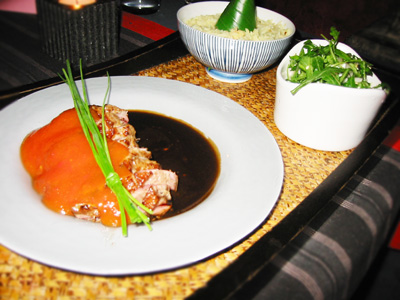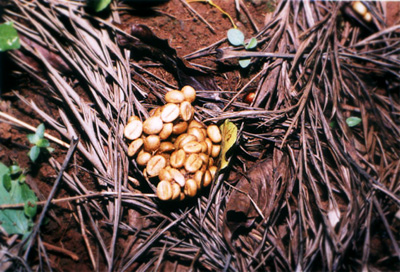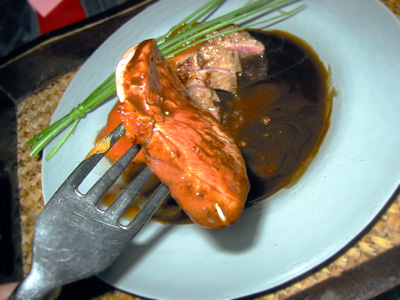Crap Food. Pan-Fried Duck Breast with Kopi Luak Sauce. Champor-Champor, London, England. (Written by Zahed Amanullah.)

Deep End Dining at Champor-Champor.
Wait a minute. Who am I? I’ve been asking myself the same question for years. Eddie and I go way back… far enough back for me to have incriminating pictures of him in high school trying to dress up like the long lost Chinese member of Run DMC. Hmm… he was still doing that three years ago. Never mind.
Back when Eddie and I were penniless roommates in San Francisco over 10 years ago, we found creative ways of getting the most for our culinary buck - and not just 10-for-a-dollar ramens or 99-cent Whoppers at Burger King, either. I remember descending on an unsuspecting dive selling all-you-can-eat buffalo wings for $6. Two hours and fifty wings later (that’s fifty each), we were (not so) politely asked to leave. You can still see our pictures on “Do Not Serve” posters by the counter… if they’re still in business. Over time, I saw Eddie’s deep end cravings nurtured across the city (and our kitchen), daring each other with chicken feet in Chinatown or garlic ice cream at The Stinking Rose (when that place was still a curiosity).
Eventually, we went our separate ways to lead parallel lives. I moved to London, he moved to Los Angeles. We met our future wives at the same time and had baby girls born within a week of each other. He found a home on the web - and KCRW - with Deep End Dining. I found a home on the web - and the occasional BBC interview - with alt.muslim, the site I run with my twin brother. And all was well with the world.
But now that the Deep End sea is getting fished clean, Eddie asked me if I had any ideas for him. I told him that London is a cornucopia of craziness, with freaky foods everywhere (and that’s just the English food). England is home to the top rated Michelin restaurant in the world in 2005, the notorious Fat Duck in Berkshire, which managed its feat with dishes such as grain mustard ice cream and snail porridge. While Eddie and I save up to dine at this Deep End deity someday, what follows is my first foray into the murky, though shallower, waters.
Cream in your Kopi
Every now and then, you can find a delicacy that simply should not exist except for the utter daftness of its discoverers. There is, for example, the fable of a monk in ancient times who wanted to commit suicide in a relatively painless fashion. He chose to eat the bitter cassava, a plant that naturally produces cyanide, to end his miserable days. But to soften the mortal blow, he cooked and sweetened it, inadvertently neutralizing the poisons within (tribes in Central and South America had already figured this out long before). The result? Tapioca pudding. Choke on that!
Likewise, the discovery of bleu cheese came by accident, when cheese stored in caves where mold was naturally present accommodated new colonies of the stuff. Taking the five-second rule to an absurd level, some anonymous individual felt that all that hard work shouldn’t go to waste, and now you can enjoy the result with your McDonald’s side salad. One can only assume that countless other moldy foods have been tried by many in a gastronomic gold rush to no avail. Pity them.
But if the brave discoverers of tapioca and blue cheese deserve remembering, the discoverer of kopi luak deserves their own national holiday! Unlike those foods, kopi luak is no accident. Kopi luak is born of insanity.
The palm civet cat (called luak in Malay), a species related to the mongoose and native to Sumatra, loves to dine on perfectly ripe coffee beans in the jungles (or farmer’s cages) of the region, which is home of some of the world’s finest coffees to begin with. However, its body only partially digests them, and the remnants lie scattered in the forest. At that time – and this discovery must be one of the greatest food stories never told – legions of Juan Valdez types pick the beans out of the excrement and compile the world’s most expensive coffee for the world’s most gullible drinkers. A Vietnamese variant, Ca Phe Chon, is similarly prized and rare, but produced by a weasel instead. Only 50 kg of the stuff is produced for export each year.

Kopi luak beans in the wild.
The resulting butt-bean brew, now called kopi luak (coffee from the luak), is partially fermented in the luak’s stomach, which takes the edge off the bitterness. It is also said to have a flavour imbued with the scent from glands in the cat’s anal region. Again, it bears questioning how this information was derived. It’s as if someone tried making (and succeeded in selling) cornbread from my corn-on-the-cob picnic lunch – something too horrific to think about (and I’m sure you’ll thank me for making you do just that).
Recently, I read a review of a critically acclaimed Malaysian restaurant in the Southwark area of London that mentioned the use of kopi luak in an actual dish – Pan-Fried Duck Breast with Kopi Luak Sauce – raising it from the realm of mere fraternity prank to haute cuisine. I knew I had to try it for my first ever Deep End Dining review. You can’t dine much deeper than from the bowels of a luak.
Champor-Champor
I phoned the restaurant, called Champor-Champor (a Malaysian expression loosely meaning “mix and match”), to make a reservation only to discover that the dish I read about was offered only on a special menu the month before. Crap. I pleaded my case and asked for special consideration in light of my new interest. The manager, Charles, said he’d ask his Malaysian chef partner to consider it. Perhaps responding to the positive interest, Charles later wrote back to tell me that the chef agreed to cook the dish especially for me (though they later offered it to the whole restaurant as a special dish for the night, the lucky devils).
From the exterior, Champor-Champor is a fairly nondescript place. Down the proverbial dark alley, it lies just beyond a long tunnel that crosses the tracks of the London Bridge train station. The tunnel also links up to a subterranean nightclub, from which a long queue of people stretched. Little did they know that the more potent drugs were a few meters away.
The interior, however, is another story. Newly renovated with Malaysian artifacts and intricate carved teak surrounds on the doorways, it’s romantic to a fault. The restaurant interior was table-bumpingly dark (all the better for not closely inspecting your food), with soft lights and candles everywhere and semi-private mezzanines for two for those who wished. My reserved table was identified by a handwritten card with my name on it.
“I had a look at your website,” Charles told me. “I found it very interesting.” By this I assumed he meant he would have none of our piss-taking of the precious delicacy I was about to order. But Charles was happy to indulge us, serving us an appetizer of made with water buffalo - though I wouldn’t have guessed that from the taste). He also let me in on a few secrets, such as the source of his beans (the UK’s www.edible.com, which sells a 57 gram bag for £23, along with other nasties such as scorpions and snake vodka) and other adventurous restaurants in the area (you’ll have to wait to hear more, naturally). Kopi luak is also available from Armeno Coffee Roasters in Massachusetts for $120/lb and AnimalCoffee in Australia in boxed gift sets.
Before long, my scatological supper arrived. The duck breast was prepared “pink,” as I was warned earlier, and I soon began to understand why. Several slices were lined up, well garnished, in pool of thick brown sauce resembling… well… brown sauce (for the uninitiated, a sweet, vinegary, ketchup-like condiment popular here in England). However, as one of the darker poultry meats, this would have turned the evocative into the literal… dark brown textured clumps in liquid crap.
However, the rare duck meat did allow the kopi luak to take the visual center stage. With any other sauce, the sheer amount laden into the plate would be overkill, justifying a hasty return to the chef. But the duck, of course, is not why we’re here in the first place. It cowered and slumped in the presence of the mighty kopi luak, submitting itself as a mere vessel for transport. All aboard!

I gathered my strength, sliced a strip of duck, smothered it, and took my first bite. The pink duck meat folded itself into the corner of my mouth after lacing my tongue with kopi luak. It resembled a smoky molé, the slightly sweet Mexican sauce made with chocolate, and had a strong and distinctive flavour that left a clean aftertaste. Thankfully, the taste of duck never challenged the kopi luak, and its texture was an adequate complement. I found it hard to imagine a sauce like this served any other way. There was more than enough sauce to cover every bit of duck and then some, leaving me to scrape up every bit of it left over - another good reason for serving this dish in near darkness.
Champor-Champor also serves kopi luak as a “hot drink” (calling it mere coffee would not do justice to its allure or price… though I am tempted to call it a “crap-a-cino”). I decided to pass for now, perhaps saving it for a beverage review that would compare it with similarly concocted drinks (oh yes, there are many). I also wanted the sauce to linger on my palate as long as possible, or at least until I could figure out a way to describe it, though ultimately there is an aspect of it that is indescribable.
It’s not hard to imagine that somewhere out there lies a food - like kopi luak - that is so otherworldly and transcendental that it is only revealed to the most daring of those among us, those who are willing to try anything to find it. As for me, I’m willing to share in the discovery …once it has been found, sanitized, and well garnished by someone else. Good things come to those who taste… everything!
(This post by Zahed Amanullah. Zahed is Deep End Dining's London contributor. He is also Associate Editor at alt.muslim.)
Comments
Despite the icky origins, I am now curious to see if the Malaysian restaurant in Chicago serves anything made with kopi luak. Believe me, I've eaten stranger. Pig blood soup, anyone?
you've inspired dalian. (personally, i feel kopi luak is waaaay funkier than pig blood soup. it's poop vs. blood.)
also, sam breach is looking forward to more stuff from the UK. you got the nod from the headmistress herself. you may have well been knighted. sir za. nice.
According to Miguel del Barco, Jesuit missionary and early, um, back end diner, native Californians reused undigested pitahaya (dragon fruit) seeds gathered from their own feces. They would gather their waste carefully, air dry, then sort through for the prized seeds, clean, wash, toast and enjoy! Again.
now is this how the narcotics "mule" was inspired?
back end diner? very funny. i wonder if that domain name is still available?
it sure is. so far.
What I am curious about is the civet aroma: is there any? I used civet oil as a scent for years, usually mixed with ambergris (is there a dish using those two together somewhere? would even you two dare eat it?) and it's rather pungent. If there was much of the it in the sauce, and it seems from "flavour imbued with the scent from glands in the cat’s anal region" that there is, it would seem...off-putting, to say the least.
The fermenting and aging it gets in the gut of the kopi luwak certainly does contribute a unique smoothness and complexity, though I think that some of the longer wet fermentation processes begin to approach the same effect. But it's not really worth what it sells for, except as a learning experience. I don't at all regret having enjoyed a pound of the stuff, but I'm not buying it again since I can get more than ten pounds of equally good coffee for the same price. More if I home roast it, as I generally do.
It's expensive stuff, but if you put kopi luwak in front of me I'll drink it happily. Or eat it with duck. Seems a bit of a waste (pun intended) to make a mole sauce out of this tasty beverage, but if I was going to cook with it I'd probably go in a similar culinary direction.